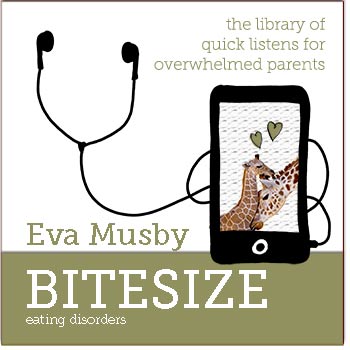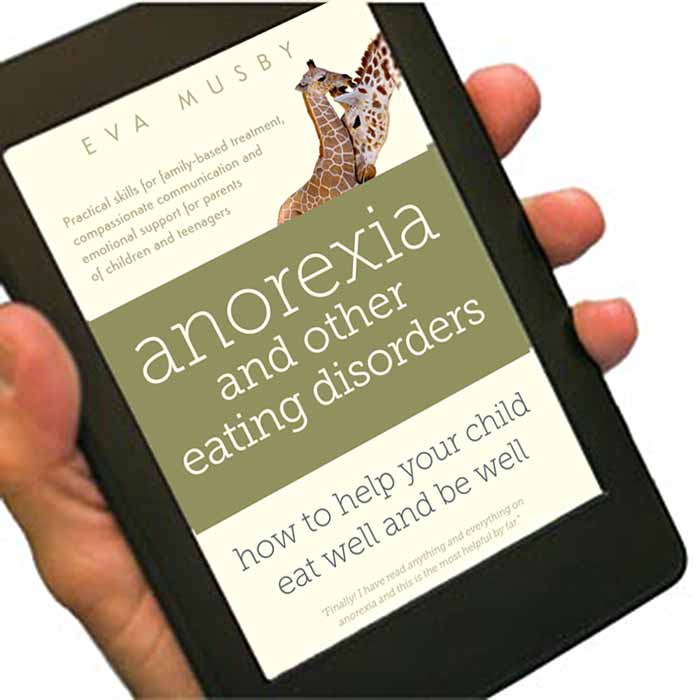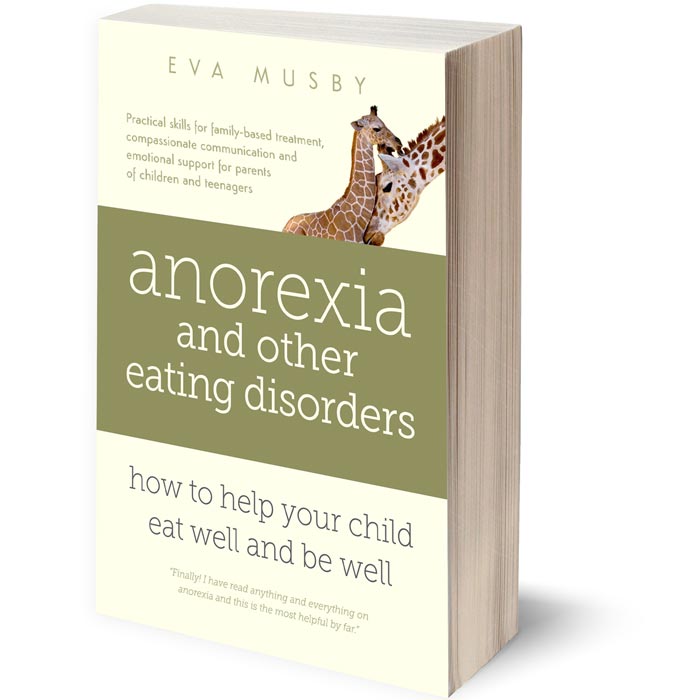Last updated on December 27th, 2023
Our children remain stuck in an eating disorder while they fear certain foods or situations. Practical tips for parents to extinguish fears and restore flexibility.
This is a section from Chapter 9 of 'Anorexia and other eating disorders – how to help your child eat well and be well'
- For some more 'live' help, I also provide a workshop in which I cover exposure to fearful foods or situations
- And there are audios on exposure work and fear foods in my Bitesize audio collection. For instance in the clip below I suggest ways to talk with your child about exposure work:
You can also get an entire free helpsheet on extinguishing fears with exposure.
Extinguishing fears, returning to flexibility

Our children are bound by rules and rituals. While these are frustrating for us, they have a function for our child: they provide short-term protection from surges in anxiety or disgust. It makes sense that a human being clings to momentary safety, even though overall this makes life fearful, rigid, rule-bound, and small. In this chapter I’ll propose ways for us, as parents, to help our children become free so that they can enjoy a rich, expansive life.
In this chapter I’ll use the word ‘coaching’ when describing what parents do at home, and often works very well.
And when I talk of ‘exposure therapy’ I’ll be referring to methods, based on ongoing research in eating disorders.
[Jumping to another section of the chapter…]
The safety behaviours our children cling to
In this chapter we’re talking about ‘safety behaviours’, such as counting calories, chewing slowly, doing star jumps after a meal and other compulsions. We’ll include in ‘avoidant behaviours’: avoiding ice cream, avoiding resting, avoiding eating in public. And any reactions driven by disgust. These behaviours are all self-reinforcing. ‘The bad things I fear didn’t happen when I followed my rules, so that means my rules work. Without the rules, the bad things would certainly happen.’ Our children may recognise that their rules are not logical, and that overall safety behaviours make life harder. But until they experience that the rules are not needed, usually nothing changes.
That’s where exposure comes in: doing the fearful thing (e.g. eating ice cream, not counting calories) and preventing the person from compensating with a magic rule. (If you’ve heard of Exposure and Response Therapy (ERP), ‘response prevention’ is about preventing use of safety rules.)
When is a good time to challenge a safety behaviour?
If your underweight child is terrified of everything except apple and kale, you have no choice: you must serve high calorie foods, and you must serve those feared carbs and fats. It’s a life-saving intervention. Console yourself with the thought that your child would have resisted a useless low-fat yoghurt just as fiercely as they fought your creamy pasta.

The start of treatment also presents an opportunity to set the parameters: no purging, no sport, parents in charge of meals, and so on. This way many safety behaviours are nipped in the bud before they get entrenched. And at the same time, we can’t achieve complete normality from week one. It’s already so hard for our children to just eat. They’re malnourished, confused, self-hating, in a state of massive anxiety, and they may not cope with exposure to every single fear. So it’s likely you’ll be leaving some tasks till later, and that you’ll tackle them gradually. Think of the two ways you might peel off a Band-Aid:
“When we were aiming for weight gain, we ripped. When we were working through the list of fear foods, we tugged.”
Once our child’s brain is better nourished, there’s a decent chance they’ll be less fearful, more flexible, braver. Some of the work towards normality may even happen all by itself:
“I do remember worrying about the fact that my daughter became very stuck on the same diet plan and we never introduced any fear foods. I needn’t have worried because actually she went from the very restricted diet plan to eating everything literally overnight.”
So do as much as is feasible at the start, and remember to work on the rest later. But… you can probably shake things up and work on bringing back the old ‘normal’ earlier than you think.
One situation where exposure work is urgent (along with the work towards independence – see Chapter 10) is if your child intends to leave home soon. They’ll need time to consolidate before they’re safe to go.
Weight gain isn’t enough
Careful! There’s a misconception that with weight gain, all fearful thoughts and rigid behaviours disappear. If your child gets discharged too early, purely because they’ve reached a target weight, please know you can keep them progressing through exposure work and coaching.
[Jumping to another section of the chapter…]

Should you collaborate with your child?
With exposure therapy, a patient is never ‘forced’. Everything is a collaboration – even the agreement that the therapist may bring in some surprises. In treatment for ARFID collaboration is the norm, and some parents of autistic youngsters say that getting buy-in is the only way to be both safe and effective.
With parent coaching, ideally we would collaborate with our child. And happily, some youngsters are willing to shed at least some of their safety behaviours. My daughter realised that she couldn’t possibly have the Christmas she wanted with the wider family, if she couldn’t sit for one hour in the car. She was (reasonably) motivated to find the courage to practice sitting during short car journeys.

On the other hand, in the inpatient unit, she had 11 months of being consulted on her meal plan, and her range just shrunk.
To bring back flexibility in spite of our children’s resistance, we parents often have to make the decisions. This means we can’t yet give our child independence (Chapter 10).
We took our daughter through many fear foods in spite of her protests, and it worked well and fast. Her mental state improved tremendously. I put it down to her being generally less frightened, to enjoyment and a sense of freedom and empowerment. If we had waiting for her willingness to eat a cookie or eat in a café, I suspect she’d have stayed ill a very long time.
Occasionally a parent tells me that their child, who for a long time could absolutely not collaborate, is now motivated to take on all kinds of challenges. Oh joy! So why not let them take the lead. Be alert, though. Don’t let them have blind spots (‘I don’t need unhealthy food!’) and don’t let them go so slowly that they’re standing still.
[End of extract from the chapter]
In this chapter:
- Extinguishing fears, returning to flexibility
- The safety behaviours our children cling to
- When is a good time to challenge a safety behaviour?
- Weight gain isn’t enough
- Dealing with fears: parents and professionals
- List those fears
- Pick an item from the list
- Should you collaborate with your child?
- ‘Why are you torturing me with ice cream?’
- Should your child feel the fear or be soothed?
- What does your child actually fear?
- The fears associated with eating out
- Example: from packaged food at home to eating anything anywhere
- Gradual steps, or dive in?
- Ideas to make the steps gradual
- Repeat and vary
- A flowchart to guide your exposure work
- When your child doesn’t manage
- Moving through the exposure list
- Forewarn or surprise?
- Your persistence
- Success breeds success
- When can exhausted parents take a break?
Where to next?
* Next: Chapter 10: The work towards full recovery and independence *
* How to get your child to cope with calories on menus (and get free of the eating disorder) *
* If your child has ARFID, there are specific approaches. See 'The main eating disorders: binge eating, bulimia, anorexia, ARFID and OSFED' *
* If your child is autistic, you may be inspired by these experiences parents have shared with me: 'Autism and eating disorders: individualising treatment for your autistic child or teen' *







HI again Eva
will you be putting a page number reference after your comment of 'I talked about the Magic Plate system earlier? This is totally addictive reading, now have a numb bum and need to dance:)
Eva, this is the best description of exposure therapy for eating I have read. We've been at this for a while, and I still learned so much from your experience. I feel recharged!
Recharged!! Oh wow, Iris, this so validates everything I'm wanting to do. Thank you for letting me know.
I'm sorry you've been at this for a while and send my wishes for you to reach the end of the tunnel very soon.